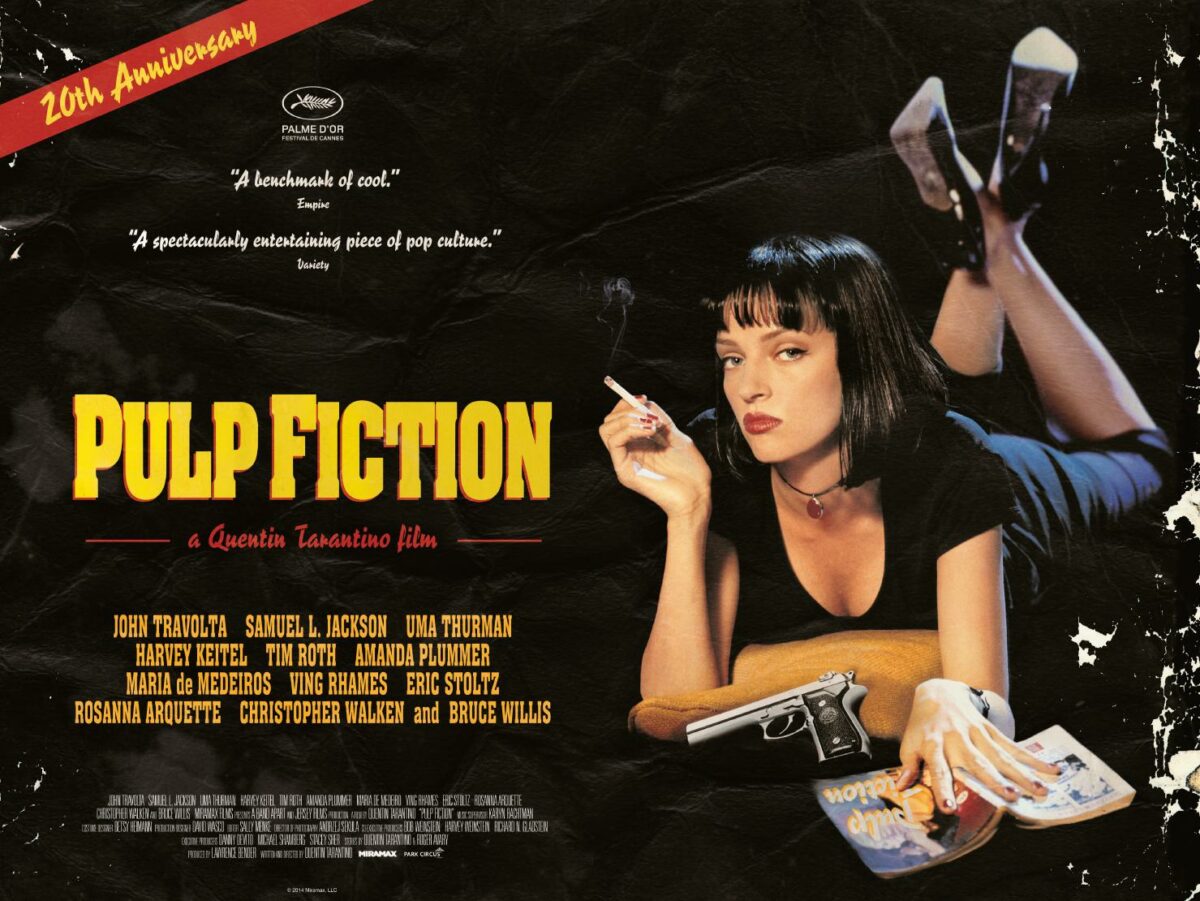Introduction:
“Pulp Fiction” (1994), directed by Quentin Tarantino, stands as a cinematic landmark that defies conventional storytelling and captivates audiences with its non-linear narrative, memorable characters, and genre-blurring brilliance. Revered as a cultural phenomenon, the film not only rejuvenated the crime genre but also left an indelible mark on the landscape of 1990s cinema. In this extensive review, we embark on an exploration of “Pulp Fiction,” analyzing its groundbreaking narrative structure, iconic characters, thematic depth, stylistic innovation, and enduring impact on popular culture.
Groundbreaking Narrative Structure:
- Nonlinear Storytelling: At the heart of “Pulp Fiction” is its non-linear narrative structure, challenging traditional storytelling conventions. Tarantino weaves interconnected stories, presenting them out of chronological order. This bold narrative choice not only adds complexity to the plot but also invites audiences to actively engage with the film’s puzzle-like structure.
- Juxtaposition of Scenes: The film juxtaposes seemingly disparate scenes, creating a tapestry of interwoven narratives. Scenes that would conventionally serve as climaxes in other films are strategically placed, leading to a continuous sense of anticipation and intrigue throughout the viewing experience.
- Reservoir Dogs Connection: “Pulp Fiction” shares thematic and stylistic elements with Tarantino’s earlier film, “Reservoir Dogs” (1992). The use of non-linear storytelling further solidifies Tarantino’s signature narrative approach, creating a distinctive and influential style.
Iconic Characters:
- Vincent Vega and Jules Winnfield: John Travolta and Samuel L. Jackson deliver memorable performances as Vincent Vega and Jules Winnfield, the film’s central hitmen. Their banter, philosophical conversations, and unexpected encounters with divine intervention make them iconic figures in cinema history.
- Mia Wallace: Uma Thurman’s portrayal of Mia Wallace, the enigmatic wife of mob boss Marsellus Wallace, adds a layer of complexity to the narrative. The character’s dance sequence and her intertwining storylines contribute to the film’s allure.
- Butch Coolidge: Bruce Willis’s portrayal of Butch Coolidge, a boxer entangled in the criminal underworld, brings depth to the film. Butch’s storyline, marked by themes of honor and betrayal, adds a noirish quality to “Pulp Fiction.”
Thematic Depth:
- Moral Ambiguity: “Pulp Fiction” explores moral ambiguity, blurring the lines between right and wrong. Characters grapple with ethical choices, and their actions often defy conventional notions of morality. The film invites viewers to question the ethical compass of its colorful cast.
- Redemption and Coincidence: The film introduces themes of redemption and coincidence, highlighting the interconnectedness of seemingly unrelated events. Characters find moments of redemption in unexpected places, and chance encounters shape their destinies.
- Pop Culture References: “Pulp Fiction” is steeped in pop culture references, from dialogue to soundtrack choices. Tarantino’s homage to various genres and eras creates a cinematic experience that resonates with film enthusiasts and casual viewers alike.
Stylistic Innovation:
- Dialogues and Monologues: Tarantino’s signature dialogue style, marked by witty banter and memorable monologues, permeates “Pulp Fiction.” The script’s sharpness and the delivery by the cast contribute to the film’s quotable nature.
- Soundtrack: The eclectic soundtrack, featuring a mix of surf rock, soul, and iconic tracks like “Misirlou” and “Girl, You’ll Be a Woman Soon,” enhances the film’s atmosphere. Tarantino’s meticulous use of music creates a sonic landscape that complements the on-screen action.
- Cinematography and Aesthetic Choices: Cinematographer Andrzej Sekula’s work, coupled with Tarantino’s aesthetic choices, brings a unique visual style to “Pulp Fiction.” The use of unconventional camera angles, close-ups, and the iconic Uma Thurman dance sequence contribute to the film’s visual richness.
Enduring Impact on Popular Culture:
- Oscar Success and Critical Acclaim: “Pulp Fiction” garnered critical acclaim and won the Palme d’Or at the 1994 Cannes Film Festival. Its success continued at the Oscars, where it received seven nominations and won the coveted Best Original Screenplay award.
- Revival of Independent Cinema: The success of “Pulp Fiction” played a pivotal role in the revival of independent cinema in the 1990s. The film’s box office triumph and cultural impact demonstrated the viability of non-traditional narratives and unconventional filmmaking.
- Cinematic Homage: “Pulp Fiction” has become a touchstone for filmmakers paying homage to the world of crime, pop culture, and non-linear storytelling. Its influence is evident in countless films that draw inspiration from Tarantino’s bold and innovative approach.
- Cult Following: The film has amassed a cult following that transcends generational boundaries. Its enduring popularity is reflected in the continued celebration of anniversaries, special screenings, and the film’s pervasive presence in popular discourse.
Conclusion:
“Pulp Fiction” (1994) stands as a cinematic milestone that defied conventions, reshaped storytelling norms, and left an indelible mark on the cultural landscape. Quentin Tarantino’s audacious narrative choices, memorable characters, thematic richness, and stylistic innovation contribute to the film’s enduring appeal. As audiences continue to revisit the interconnected tales of hitmen, boxers, and gangsters, “Pulp Fiction” remains a testament to the transformative power of cinema, proving that a film can transcend its status as mere entertainment to become a cultural touchstone, influencing storytelling for generations to come.
